One of the greatest seasons for foraging is autumn. Many plants are already bearing fruit after soaking up the warmth and moisture of the summer. The chill has not yet wiped out the wild plants, making it the best time to forage before the snow hits. And there are also a variety of mushrooms available for harvesting during this time.
Foraging for mushrooms is not as dangerous as many of us have been made to think, but it does call for some knowledge, persistence, and prudence. While it’s true that certain mushrooms are deadly, there are also many that are simple to recognize and are completely edible.
The key to foraging mushrooms in fall properly is understanding what is accessible during the season, and the key to keeping safe is avoiding unfamiliar mushrooms. There are certain plainly recognizable autumn fungi to watch out for, so avoid anything that may be mistaken for something dangerous.
In this guide, we’ll explore nine great mushrooms to forage in autumn, their classification, key identifying features of each mushroom, and more.
1. Oyster Mushrooms
The most well known oyster mushrooms is Pleurotus ostreatus. The name of these delectable mushrooms comes from how much they resemble real oysters. They develop in clusters on dead or dying trees, mostly hardwoods. They have very prominent gills. Sometimes they may appear to be emerging from the earth, yet there is unquestionably a dead tree buried beneath them.
There are also lilac variations, albeit these are often white to cream or gray to brown in hue. They have decurrent gills, meaning they run down the stem.
Almost every recipe may benefit from the addition of oyster mushrooms. They go nicely with meat, poultry, and white wine sauce in particular.
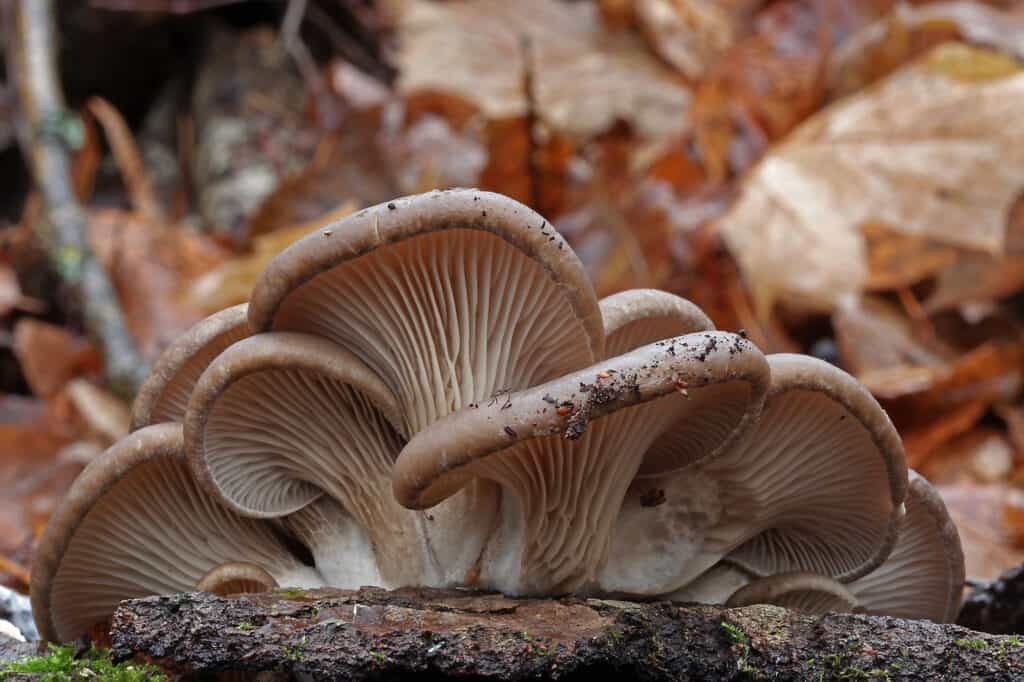
Oyster mushrooms (pictured) are one of the easiest mushrooms to forage for in autumn.
©NK-55/Shutterstock.com
2. Puffball Mushrooms
One of the more well known puffball mushrooms is Lycoperdon perlatum. When mature, puffballs are relatively simple to recognize. Some puffballs, like Calvatia gigantea can grow to huge sizes. Puffballs frequently grow on or next to trails because they seem to prefer disturbed regions. When young, certain mushrooms resemble puffballs, but all you need to do to tell them apart is cut one open. Fresh puffballs will be white inside and there will be no sign of a stem, gills, or cap. Otherwise, it is a different species of mushroom and should not be eaten. It’s important to note that young puffballs resemble the dangerous death cap fungus, so use caution when harvesting. Some Scleroderma species can also look similar when young, but they will be much more firm and the inside will have turned from white to dark unless it is extremely young.
Consider adding puffballs to various breakfast recipes or frying, slicing, and breading them. They may even be used by some people to create a gluten-free alternative to pizza or pasta dough. Like tofu, puffballs have a mild flavor but take on the flavor of the other items they are cooked with.
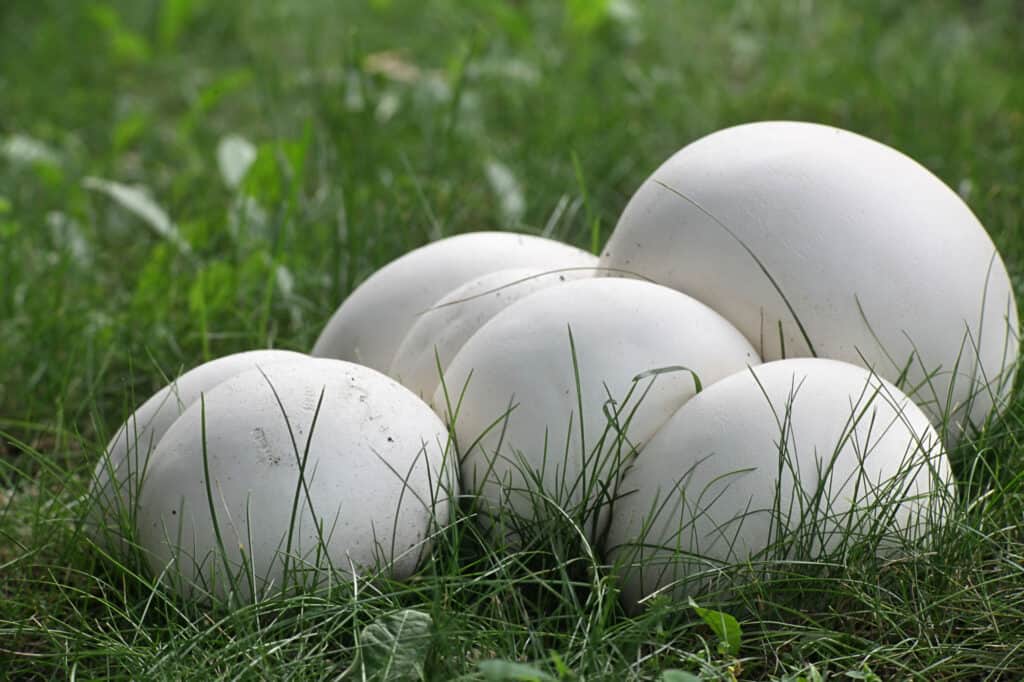
Puffball mushrooms (pictured) are unique in that they lack stems, gills, and caps.
©Henri Koskinen/Shutterstock.com
3. Honey Mushrooms
One of the more commonly known honey mushrooms is Armillaria mellea. With a few exceptions, honey mushrooms are among the greatest fall mushrooms available. If the circumstances are ideal, you may leave your favorite area of the forest carrying a literal truckload of them.
A parasitic fungus, honey mushrooms infect trees and vast tracts of forest. Since my preferred species grows on oaks, I keep an eye out for forests with hardwoods that are overgrown with dead and rotting wood even when they aren’t fruiting. The rings on their stems and the tiny hairs on their crowns serve as telltale signs of them. It should be noted that there are some honey mushrooms that do not have a rung on the stem as well.
Honey mushrooms pair well with tomatoes, sausage, rice, potatoes, and pasta in addition to being excellent for frying. However, to avoid any chance of gastric upset, some mushroom cooks advise pre-boiling honey mushrooms for at least 10 minutes and many do not eat the stems.
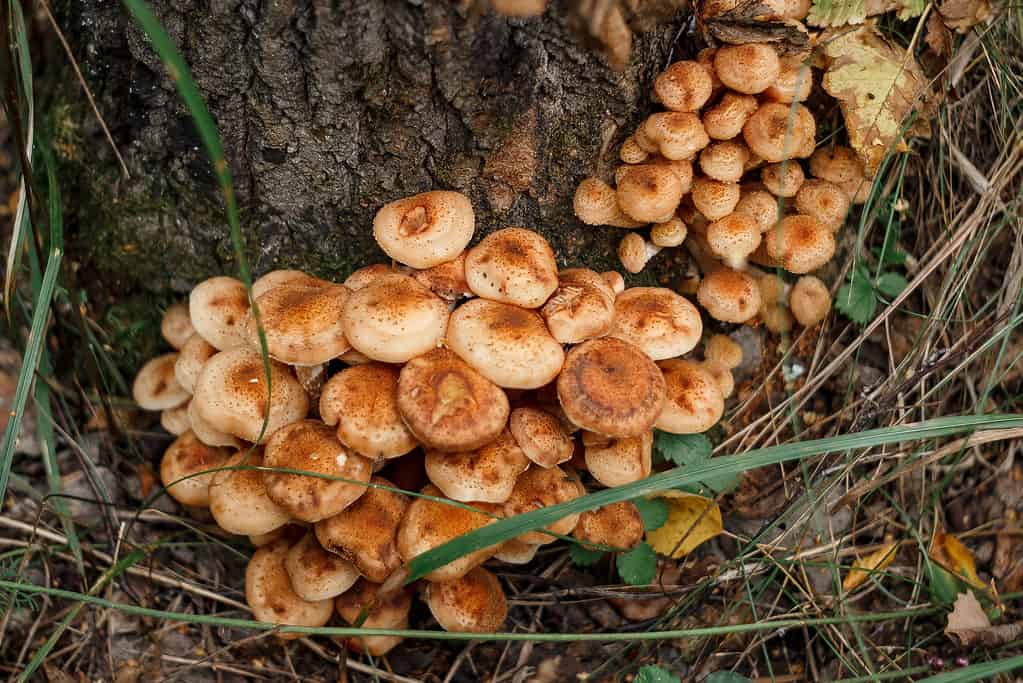
Honey mushrooms (pictured) must be cooked before eating to avoid any potential toxicity.
©Roman Milavin/Shutterstock.com
4. Chicken of the Woods Mushrooms
One of the more common species of chicken of the woods is Laetiporus sulphureus. Due to their vivid colors and enormous size, these polypores are quite difficult to mistake in many areas of the world, but there have recently been newly discovered species in Florida that can look very similar. The texture is somewhat like chicken and they have an excellent chewy texture.
On wood or, it appears, at the foot of trees where they have emerged from subterranean wood, chicken of the woods grows. On top, they are orange to yellowish, and on the bottom they are yellow. Although some species like Laetiporus cincinnatus are white on the bottom. They develop as a collection of crowded shelves rather than stems or tops. They have pores instead of gills, like other hen of the woods.
Foraging for these mushrooms in the fall is easy. They may be a terrific source of free food, encourage plenty of enjoyable trekking during a picturesque time of year, and give big nutritional benefits for less work. Even though they are simple to recognize, it is crucial to use caution whenever you gather plants or mushrooms in the field. Use social media support groups and a mushroom identification reference until you get some experience with foraging.

Chicken of the woods mushrooms (pictured) are popular foraging mushrooms because they taste like chicken.
©nomis_h/Shutterstock.com
5. Hen of the Woods Mushrooms
Hen of the woods mushroom is classified as Grifola frondosa. The hen of the woods mushroom is without a doubt one of the most well-known and delectable foraged mushrooms. One of these mushrooms may weigh up to 20 pounds without seeming unusual. That’s a lot of mushroom!
Hen of the woods are polypores, which means their undersides are covered in tiny holes rather than gills. The underside is white, and the tops are brownish and grey. These mushrooms usually grow close to the bases of both live and dead oak trees because they like the companionship of oak trees.
Once you have seen it a few times it is hard to mistake the hen of the woods mushroom due to its highly unique appearance. When recognizing a hen of the woods mushroom, it’s important to weed out the look-alikes as well. Berkley’s polypore, black staining polypore and the umbrella polypore can all look quite similar to the untrained eye, but luckily none of them are toxic.
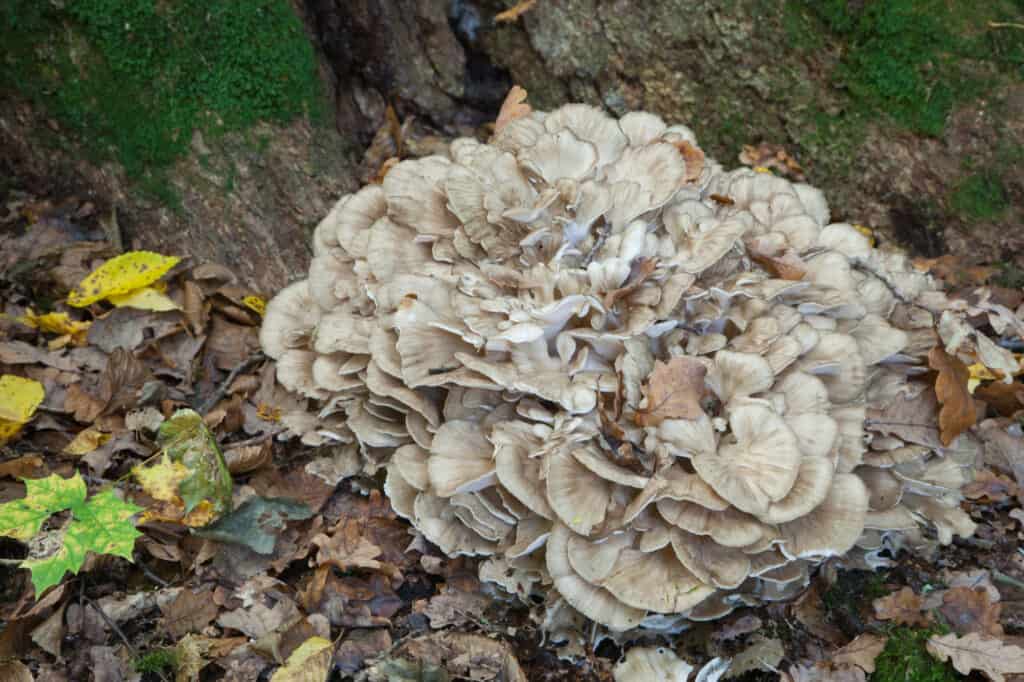
Hen of the woods mushrooms (pictured) can almost always be found near oak trees.
©Aleksander Bolbot/Shutterstock.com
6. Lion’s Mane Mushrooms
Lion’s mane mushrooms are classified as Hericium erinaceus. One of the most iconic autumnal mushrooms is the lion‘s mane. It grows in groups on hardwood trees and takes its name from the fact that it resembles the shaggy mane of a lion. When they are still white, that is the time to consume them.
Although they may be used in many dishes, such as vegan burgers and soups, these mushrooms are also thought to have therapeutic properties. According to certain studies, this mushroom may even benefit individuals suffering from neurological disorders and be good for the brain.
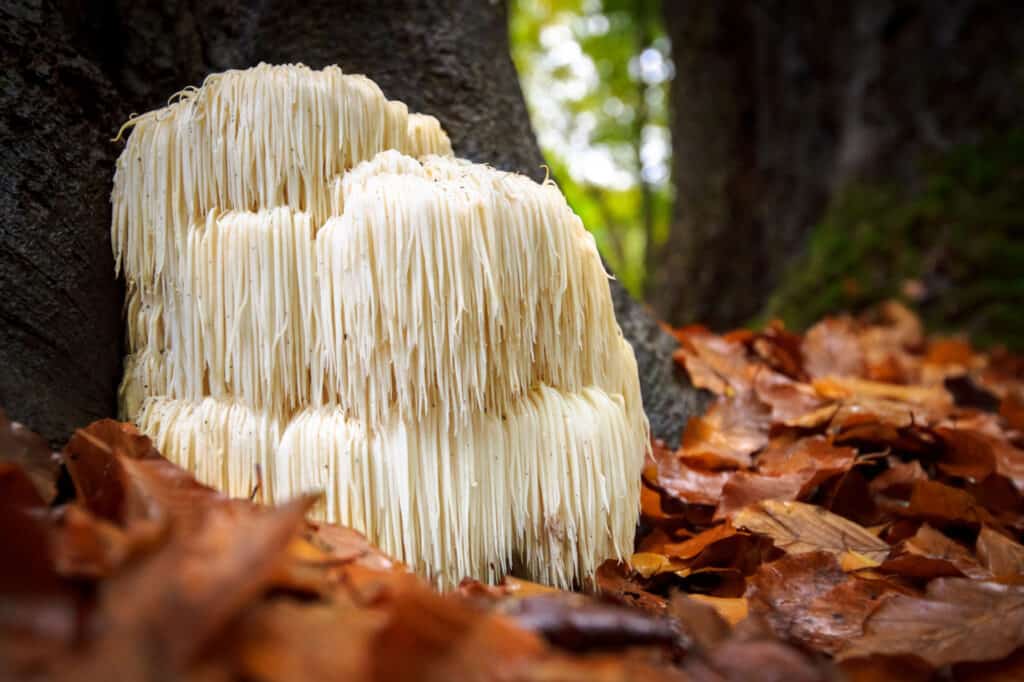
Lion’s mane mushrooms (pictured) have a distinctive, hair-like appearance.
©Fotografiecor.nl/Shutterstock.com
7. Chanterelle Mushrooms
There are many species of chanterelle mushrooms, Cantharellus cibarius being the most popular and well known species. Chanterelles are simple to recognize and are frequently present in considerable quantities. In the Pacific Northwest, you will likely find Cantharellus formosus and it’s not unusual to locate 20 pounds or more of these chanterelle mushrooms in a single afternoon when the conditions are ideal.
Although there are also white variants, chanterelles are frequently quite orange or yellow in color. One of the key factors contributing to their abundance in the Pacific Northwest is that they like damp soil in old-growth forests. They can occasionally be seen in tiny clusters, although they are most frequently found alone. It’s crucial to note that while they do resemble the deadly jack-o-lantern mushroom in some ways, a close examination of each mushroom reveals several distinctions. Jacks have real gills, frequently grow in groups on wood, and receive their name because they illuminate at night. Additionally, there are false chanterelles, which have hollow stems, circular, flat tops, and real gills that fork.
Chantrelles go well with almost everything. They taste great when added to soups, risotto, pickles, or just about any other dish.

Chanterelle mushrooms (pictured) are easy-to-spot mushrooms due to their bright orange-gold hue.
©Paula Savelius/Shutterstock.com
8. Black Trumpet Mushrooms
The most well known species of Black trumpet mushrooms is the European species Craterellus cornucopioides. Around July, black trumpets begin to sprout from the forest muck and bear fruit all the way through November. You will find Craterellus fallax in abundance east of the Rockies and it’s worth noting that black trumpets are reported to interact mycorrhizally with oak trees. Keep an eye on oak trees rather than the ground when searching for black trumpets.
Like many other mushrooms, some studies suggest that black trumpet mushrooms may offer several health advantages, including being rich in vitamin B12, being good for the skin, possibly preventing cancer, promoting weight loss, and lowering cholesterol. Black trumpet mushrooms are utilized as an accent or garnish in meals with a mild taste because of their smokey flavor and delicate texture.
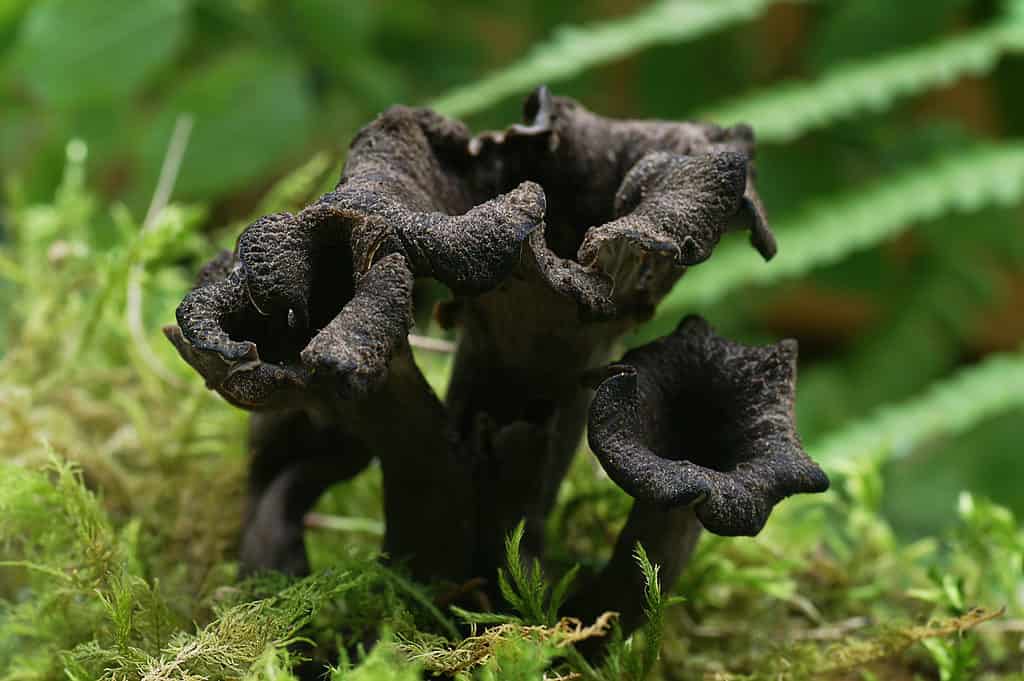
Black trumpet mushrooms (pictured) might look a bit funky, but they are delicious and quite nutrient-dense.
©Gaby Fitz/Shutterstock.com
9. Lobster Mushrooms
Lobster mushrooms are classified as Hypomyces lactifluorum. Lobster mushrooms are unique in that they are a fungus that spreads to other mushrooms. They are outstanding delicacies, so named because of their flavor and color, which resemble lobster, making them very simple to recognize. They are vividly orange and typically seen close to trees, particularly hemlocks. Be aware that these mushrooms have unusual caps and stems, no discernible gills, and a subtle fishy scent.
They are dubbed lobster mushrooms for a good reason; they have a somewhat seafood-like odor and flavor. In various cuisines, such as lobster-mushroom rolls and lobster-mushroom bisque, they are frequently used as a replacement for crab or lobster because of this.
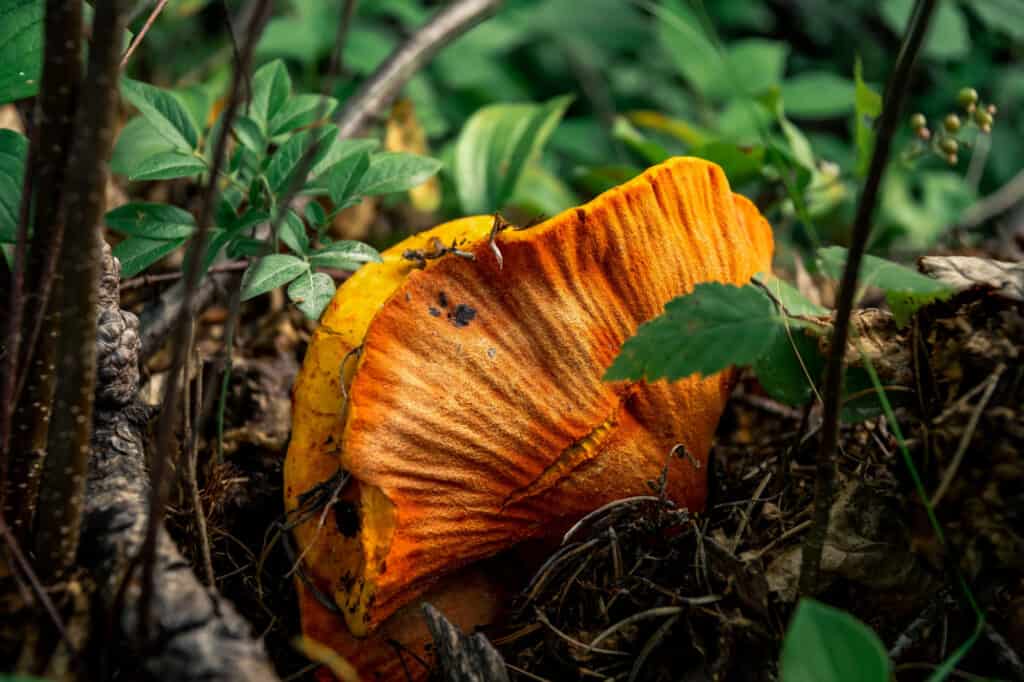
Most lobster mushrooms (pictured) have a meaty texture that make them popular for use in cuisine.
©Raphael Rivest/Shutterstock.com
Up Next:
- The 6 Best Books About Mushrooms for Beginners and Enthusiasts!
- Discover 10+ Different Types of Wild, Edible Mushrooms
- 8 Different Types of Poisonous Mushrooms You Should Avoid
The photo featured at the top of this post is © Krot44/Shutterstock.com
The information presented on or through the Website is made available solely for general informational purposes. We do not warrant the accuracy, completeness, or usefulness of this information. Any reliance you place on such information is strictly at your own risk. We disclaim all liability and responsibility arising from any reliance placed on such materials by you or any other visitor to the Website, or by anyone who may be informed of any of its contents. None of the statements or claims on the Website should be taken as medical advice, health advice, or as confirmation that a plant, fungus, or other item is safe for consumption or will provide any health benefits. Anyone considering the health benefits of particular plant, fungus, or other item should first consult with a doctor or other medical professional. The statements made within this Website have not been evaluated by the Food and Drug Administration. These statements are not intended to diagnose, treat, cure or prevent any disease.
Sources
- Benjamin Burgholzer, Available here: https://freerangeamerican.us/7-fall-mushrooms/
- Erica Landis, Available here: https://www.wideopeneats.com/fall-mushrooms/
FAQs (Frequently Asked Questions)
Is autumn a good time to forage for mushrooms?
Autumn is one of the best times to forage for wild mushrooms, especially after a humid and hot summer that makes fungi grow in abundance.
What period during autumn should I forage for mushrooms?
In North America, September and October are the best months to forage for mushrooms. In fact, you’ll find mushroom festivals around the country during these months, as it is considered the best time period for harvesting mushrooms.
When are puffball mushrooms supposed to be harvested?
Puffballs are best harvested when they are mature and not in the “egg” state, which is usually around October in North America.
Thank you for reading! Have some feedback for us? Contact the AZ Animals editorial team.






